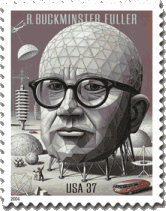This edition of Stamp Nook looks at a U.S. commemorative issued last year that was brought to my attention by Reuben in the guestbook:
At the local post office this afternoon I found something wonderful that I thought perhaps Lyle and the Philatelist would enjoy. It is not a candy heart stamp left over from Valentine's day, but one honoring R. Buckminster Fuller and the geodesic colossus of his disembodied head. ... The futurist scene is monorail-free, but it does have some kind of a three-wheeled Winnebago.
Although I must admit to not being very fond of these newer self-adhesives with their ersatz perforations, it is nonetheless a lovely looking stamp. The illustration was done by Boris Artzybasheff (more) and was originally used on a 1964 Time Magazine cover for an article on Fuller entitled 'The Dymaxion American'.
The 'three-wheeled Winnebago' is actually Fuller's Dymaxion Car. It could seat eleven, travel at 193kph, get at least 13km to the litre, perform a u-turn in its own length, and was designed to eventually be equipped with 'jet-stilts' to allow it reach a house placed anywhere on 'Spaceship Earth' (Fuller designed a Dymaxion House that could be airlifted to any location, no matter how inaccessible, and suspended from a pole; a multi-tiered variation can be seen on the left side of the stamp). The car was also sheaved in aluminium, which, I have on good authority from Lyle, made its passengers quite immune to psychotronic mind control.
It was by all technical accounts a smashing success; however a mysterious 'accident' in 1933 involving the first Dymaxion Car resulted in the death of a famous race car driver and serious injuries to two dignitaries on their way to catch a Zeppelin. This generated negative press and soured any potential investors. (Interestingly, Zeppelins, which also had coverings made with aluminium, would a few years later suffer their own mysterious accident with similarly disastrous publicity.) Although Fuller's design was later vindicated when it was learnt the fault lie with the other, conventional-style car involved in the accident (driven by a shadowy Government official who fled the scene of the crime), it was by then too late and the project died, leaving today's motorists at risk for vehicular mind control and municipalities at the mercy of marauding Monorailists.
A sordid state of affairs indeed, but all in all a very collectable stamp for the transportation topicalist.
Until next time, happy philateling!

